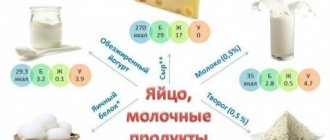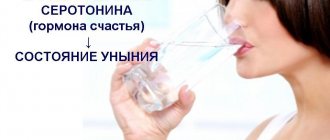In all media, on Internet portals about healthy lifestyle, there is a widespread opinion that a person consists of 75-80% water. Is it really? We know that the amount of fluid in the body, at a minimum, depends on several factors. This includes health status, gender differences, age and much more. Where did this exact figure come from? Let's find out...
Like 0
The role of water in the human body
Water is found in every part of the complex human body. To understand why there is so much water, let's first consider its main functions.
Perhaps the main task of water is its participation in metabolism. All substances that enter the human stomach undergo a number of complex changes in the digestive system. As a result of this synthesis, amino acids are obtained from proteins, glycerol and fatty acids from fats, and glucose from starch. As you guessed, all these processes take place in water.
The second, no less important function is to maintain osmotic pressure inside the cell, and in fact, its integrity. Since the cell must absorb and remove substances, it is a semi-permeable membrane. If we describe this process using cells as an example, it will look something like this. The pressure generated by the solution inside the cell must be equal to the pressure outside the cell. When the body is dehydrated or solutions with too high a salt content are administered intravenously, the cells will shrink and release water out. If too much pure water or a solution with low osmotic pressure (low salt content) is administered intravenously, the cell will draw in water in order to balance the pressure.
The acid-base balance in the human body is also an important factor that is regulated by the aquatic environment. For example, saliva, which is an aqueous solution, can reach a pH level of 8, and gastric juice has a strongly acidic environment with a pH of 1.5 - 2.
Heat exchange and thermoregulation also occur thanks to water. The principles of thermoregulation are to increase heat transfer when body temperature rises, and to maintain it as much as possible when it decreases. These processes can be observed when it is hot outside, that is, excess heat comes from outside, or during physical activity, when excess energy is released due to the breakdown of sugars. Then the person begins to sweat and secrete sweat, that is, water, in order to remove excess heat from the body.
The transport function of water is to ensure the delivery of nutrients by blood, lymph, and also to remove waste products - urine, sweat, etc.
Why is body fat needed?
As paradoxical as it sounds, the human body still needs fat. Weight loss fanatics can convince you otherwise until you are blue in the face, but still pay attention to this point so as not to cross the boundaries of acceptable weight loss.
Fat is necessary for the normal functioning of the body. Therefore, its content cannot be equal to zero.
Fat needed:
- For thermal insulation;
- To protect internal organs and/or the fetus during pregnancy;
- As energy reserves. This is the so-called emergency protection of our body for a rainy day.
For women, the required fat level is at least 8-10%, but for men this figure is 3-5%. A low percentage of fat is extremely dangerous for health, which especially concerns the female body. So indicators below 10-13% inhibit estrogen production, disrupt reproductive function and the menstrual cycle. There is also a risk of developing osteoporosis much earlier than old age due to decreased bone density.
By the way, women often cannot get pregnant due to lack of body weight. This is why doctors recommend certain fat-building foods for those who are “morbidly thin.”
How does the mass of water in the human body depend on age?
In the infographic below we show the water content in the human body at different age periods. The older it is, the lower the water content will be. For example, a human embryo can contain up to 90% water, an adult about 65%, and older adults about 40%.
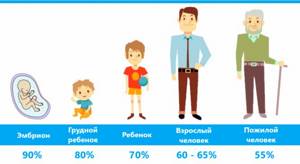
Thanks to these percentages, you can calculate how many liters of water are in the human body, for example, the body of a newborn child will contain about 3 liters of water, and a middle-aged man will contain 50 - 60 liters.
This is due to the physiological characteristics of the tissues. The child’s skeleton is elastic, which means that it contains more cartilage tissue, and therefore water. With age, bones become harder and later become brittle precisely due to the fact that their water content physiologically decreases. Skin aging and decreased vascular elasticity are also associated with a decrease in the amount of fluid in the tissues.
Fat, water and muscle ratio
If in the process of losing weight you are losing fat, not muscle mass or water, then you are definitely on the right track. But how do you find out your body fat content and what is the average? There is a special table that shows all the numbers. Let's briefly go through its data.
The average is calculated depending on the age and gender of the subject. So, due to the hormone estrogen, the female audience has 5% more fat than the male audience. Therefore, the usual normal rate is 23% for women and 17% for men.
Depending on age, the percentage of normal body fat increases and muscle mass decreases.
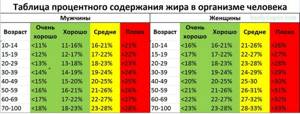
So, for an average student aged 20 years, fat content should be approximately 15% of total body weight. And older men with a clearly sedentary lifestyle have rates of 25% or more. The ideal indicator is considered the limit of obesity. Anything higher is full-fledged clinical obesity with all the ensuing consequences.
In women, the limit of obesity is considered to be 30%, but clinical obesity is considered to be 35%. When the indicator of obesity is borderline, it is worth reviewing the food in the refrigerator and throwing out all the harmful things or giving them to your enemies, as the saying goes.
Percentage of water in the human body
Now let's look at where water is primarily stored in the human body. Most of the fluid (more than 90%) will be contained in the blood. The amount of water is due to the fact that the blood should be liquid.
The lungs contain up to 83% water. First of all, this is due to the fact that they contain about 9% of all the blood contained in the body. Water also performs the function of partial heat exchange when it evaporates from the surface of the alveoli.
Bone tissue contains the least amount of fluid due to the fact that it has an ordered, dense structure, which is required to ensure strength.
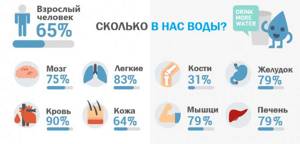
Sabji (Indian vegetable stew)
Discussion: 8 comments
- Elena:
11/20/2018 at 9:48 amVladimir, hello! Please tell me, are there creatures on our planet that drink enough water and live much longer than average with a good quality of life?
Answer
Vedich:
11/20/2018 at 9:53 am
Hello, Elena. I didn’t quite understand the word “creatures”...
Answer
11/23/2018 at 9:41 pm
Water appears inside a person in the womb. But it does not appear in the child from the outside and not from the mother. The water from which a person consists is different, it is alive. It is born along with the spark of life inside the little man. The water of which a person is composed is a liquid crystal on which all information about a person is recorded. The water that is consumed from the outside carries information about the outside world. If the physical body is very clogged and there is not enough water consumed from the outside, then the body wastes its water (a small amount) to cleanse the body. Due to this, internal resources run out and the person dies. During dry hunger, a person’s water leaves and purity is felt in the mind due to the reduction, erasing of the prescribed algorithms and programs in it. Water on Earth is water from people who once lived on it. The salt of the earth is literally the remains. Salt and water. As well as all the other minerals in the Earth. Man created the Earth. The human body and the Earth are one and the same. Man creates everything that surrounds him through his body. Man produces chemical elements. But there are also those who were created from the Earth, that is, a secondary person, essentially dead. Like animals. They have souls, since their bodies also consist of water, but they do not have the ability to create water and others inside themselves. chemical substances from which the surrounding world is created..
Answer
- Vedich:
11/24/2018 at 5:45 am
There was water on Earth long before people appeared.

Answer
11/26/2018 at 3:00 pm
Good health. Thank you for the article. Question: - Should you only drink water? I have a predisposition to green tea, I drink it during the day, it turns out to be 2; 2.5 liters (with water)
Answer
- Vedich:
12/04/2018 at 2:55 pm
Hello. Tea is not water. Moreover, in large quantities it is extremely harmful. The body requires H2O.
Answer
04/02/2020 at 10:18 am
Vladimir, you said that the healthiest water is distilled. Tell me why?
Answer
- Vedich:
04/04/2020 at 3:17 pm
I will give all the explanations in subsequent articles.
Answer
Is it harmful to drink a lot of water?
It turns out that the answer to this question is yes. With excessive water consumption, the following undesirable processes occur in the human body:
- Sleep is disturbed due to the need to empty the bladder.
- Sweating increases, which can lead to skin problems.
- The risk of swelling of brain cells increases.
- The concentration of vital elements in the body, such as sodium or potassium, is disrupted.
- Digestion is impaired as the acidity of gastric juice decreases.
In connection with the information provided, it is recommended to consume about 3 glasses of water during meals. As a result, during the day, in the case of three meals a day, it turns out that a person consumed a total of 8-9 glasses of this liquid.
Importance for normal human functioning

The main function of water in the human body is to transport various nutrients and breakdown products from one place to another. Note that a person will not be able to live if he does not drink water for 3-4 days.
If a person has lost only 2-3% of water, then he begins to feel thirsty. It is interesting to note that even with the loss of 1% of this fluid, brain function begins to deteriorate and physical abilities decrease.
Consequences of lack
A decrease in water reserves by just 2% already threatens complications. For example, memory and concentration deteriorate. In summer, the amount of liquid released through sweat reaches three liters. With breathing, reserves decrease by about 0.5 liters, with urine - by 1.5 liters, with feces - by 0.1 liters of water.
Even a small percentage of fluid loss prevents weight loss. When one liter of fluid is lost, a person becomes thirsty. Ten percent loss leads to irreversible consequences, twenty percent dehydration is fatal.
It is necessary to maintain a water regime in order for our organs to function normally and the body to maintain the desired shape. Only 30% of water enters the human body with food; the rest is replenished only by consuming liquid.
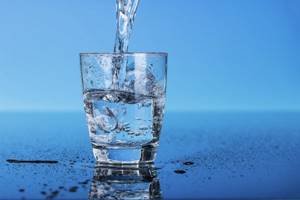
How to find out your fat percentage?
There is no exact way to say this with 100% success. There are more accurate methods, there are simple methods that show this approximately.
Identification from photographs
The fastest and easiest way. To determine your body fat percentage, you need to find a body shape that is as similar to yours as possible.
Pros: fast, free.
Cons: requires your assessment of yourself, which is not always objective. We may unconsciously “throw off” a few pounds in our minds and compare ourselves to the slimmer version in the photo.
Using a caliper
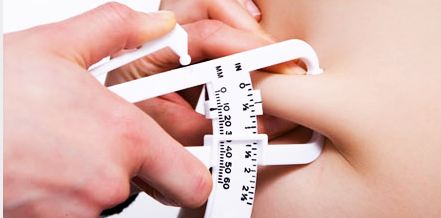
A caliper is a special device that measures the thickness of the skin-fat folds in different parts of the body. Based on the obtained figures, the percentage of fat is determined using special tables or formulas.
Method number 1: measurements for women

1. Back of the shoulder: the fold is taken vertically in the middle between the shoulder joint and the elbow.
2. On the side: the fold is taken from the side diagonally in the middle between the lower rib and the hip bones.
3. On the stomach: the fold is taken vertically at a distance of +-2.5 cm away from the navel.
We calculate the percentage of fat using the formula:
% fat = (A-B+C) + 4.03653 , where:
A = 0.41563 x (sum of all three folds in mm)
B = 0.00112 x (sum of all three folds in mm squared)
C = 0.03661 x age in years
Method No. 2: measurement for women and men

We add the resulting numbers in mm and find out the percentage of subcutaneous fat using the table:
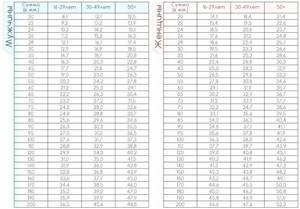
Cost: 500-800 rubles per caliper.
Pros: fast, you can do it yourself at home, fairly accurate indicators.
Cons: you need practice to learn how to use it correctly or someone else's help, calculations using formulas are required.
Bioimpedance analysis
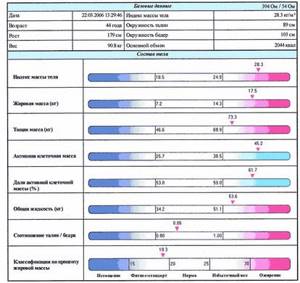
A weak current is passed through the body using electrodes attached to the ankles and wrists, after which the electrical resistance of the tissue is measured. The method is based on the fact that fat mass and the rest of the “dry” body mass have different resistance.
Cost: 1000-3000 rubles in private clinics or free under the compulsory medical insurance policy in public health centers.
Pros: fast, does not require any activity.
Cons: price, need to visit a clinic, use of equipment of varying quality. Not always accurate indicators, since the figure may be affected by water balance (edema).
Scales with fat percentage analyzer
The principle is the same as in bioimpedance: the device passes a weak current through you and calculates tissue resistance.
Cost: 2500 - 10000 rubles
Pros: fast, suitable for regular home use.
Disadvantages: the same as for bioimpedance - price, not always accurate indicators, since the figure can be affected by water balance (edema). When repeated measurements, fluid loss may show on the scale a decrease in the percentage of fat mass, although in fact it has remained unchanged.
Underwater weighing method
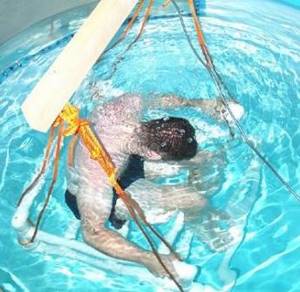
The method is based on Archimedes' law: a solid body immersed in water loses as much weight as the liquid it displaces. Since dry body mass and fat mass are different in density, the percentage of fat mass is determined by comparing body density after regular weighing and underwater weighing. The method is complex and rarely used.
Cost: Unable to find out
Pros: the most accurate method to date.
Cons: Duration 45-60 minutes, difficult procedure and likely high cost. Fear of underwater diving.
Determination by body mass index from Lyle MacDonald
The method is only suitable for untrained people, i.e. for beginners who have not yet started strength training. For the lucky owners of visible muscles built in the gym beyond the “norm”, this method is not suitable.
To determine your body fat percentage, you need to know your body mass index.
Where do we get the liquid from?

By liquid, experts mean not only water, but also any drinks in general, as well as vegetables and fruits. Broth, coffee, compote, apple, cucumber - all these are sources of liquid that our body needs so much.
True, researchers often debate about the benefits of coffee. But the effect of this drink on the cardiovascular system and intestines is a separate issue. Still, coffee saves you from dehydration. Even if you drink nothing but it, you are not in danger of dying from thirst.





